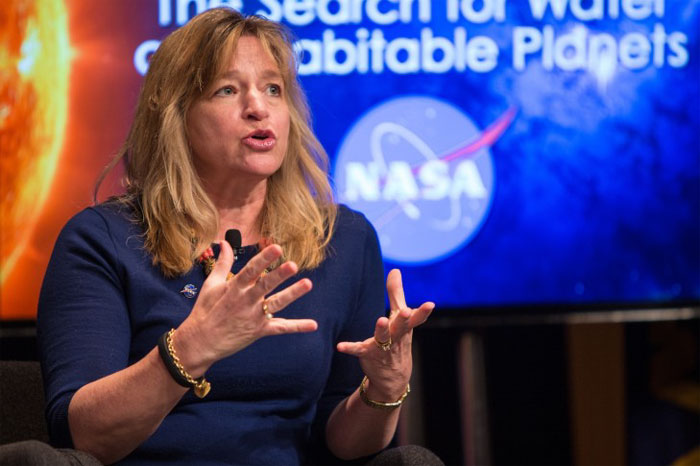.

NASA Chief Scientist Ellen Stofan told the House Science Committee Sept. 29 that an updated astrobiology strategy is nearly completed. Credit: NASA
-
WASHINGTON — A long-delayed strategy to guide NASA’s efforts to search for life beyond Earth is finally nearing completion, more than a year later than originally planned, the agency’s chief scientist said Sept. 29.
Testifying before the House Science Committee, NASA Chief Scientist Ellen Stofan said rapid changes in the field of astrobiology, an interdisciplinary science that incorporates fields as diverse as biology, chemistry, astronomy and planetary science, have delayed the agency’s efforts to complete an updated strategic plan, or roadmap, that was scheduled to be completed last year.
“The reason that it’s taken longer is that this science is evolving so rapidly, and how the scientific community looks at it,” Stofan said. “The reason for the delay in the roadmap is we’ve just been trying to get the best science from the scientific community, get it properly reviewed, and get it out as soon as we can.”
Stofan indicated that the report itself is done and should be released soon. “It will come out shortly,” she said, without providing a more specific schedule.
Work on the document, intended to update a roadmap last revised in 2008, started in 2013 with meetings of scientists, both online and during a four-day event at NASA’s Wallops Flight Facility in Virginia. The goal at the time was to complete the document and publish it in April 2014.
That schedule, though, slipped several times. In a March 31 presentation to the Space Studies Board of the National Academies, Mary Voytek, senior scientist for astrobiology at NASA Headquarters, said a draft of the report was still in development. “We are making progress, but it’s just taking some time,” she said. At that meeting, she believed the final report would be ready in time for the Astrobiology Science Conference, which took place in Chicago in June.
Stofan said at the hearing that the document, when released, will guide the agency’s review of proposals for missions or other research related to astrobiology. “We can use that at NASA and say, ‘Is this really high priority?’” she said.
Stofan discussed the astrobiology strategic plan in response to questions from Rep. Donna Edwards (D-Md.), the ranking member of the space subcommittee. Edwards was concerned about both the delays in developing the report and that, without an updated strategic plan, the significance of discoveries related to astrobiology may not be appreciated.
“I do get a little bit concerned with these constant discoveries, which are really great and we find incredibly fascinating, that the public then becomes numb to it in a way that would harm us in terms of making sure you have the resources you need,” Edwards said.
The discussion about NASA’s astrobiology strategy took place during a hearing about astrobiology in general, one day after NASA announced evidence that liquid water flows intermittently on the surface of Mars. While that discovery was a major topic of discussion, members also discussed issued ranging from efforts to detect Earth-like planets around other stars to the search for signals from extraterrestrial civilizations.
While astrobiology accounts for a small part of NASA’s overall budget — $57.5 million in 2015 — some committee members believe that research could have a far greater influence on the agency and society in general. “There are few greater adventures that the search for life beyond Earth,” committee chairman Rep. Lamar Smith (R-Texas) said at the hearing. “If definitive evidence of life is found, it may be the most significant scientific discovery in human history.”
Stofan, repeating comments she made earlier this year, believes such a discovery is likely in the next two decades. “With future technology and the instruments under development, we will explore the solar system and beyond,” she said, “and could indeed, perhaps in as little as 10 to 20 years, discover some form of life, past or present.”
Quelle: SN
4256 Views
